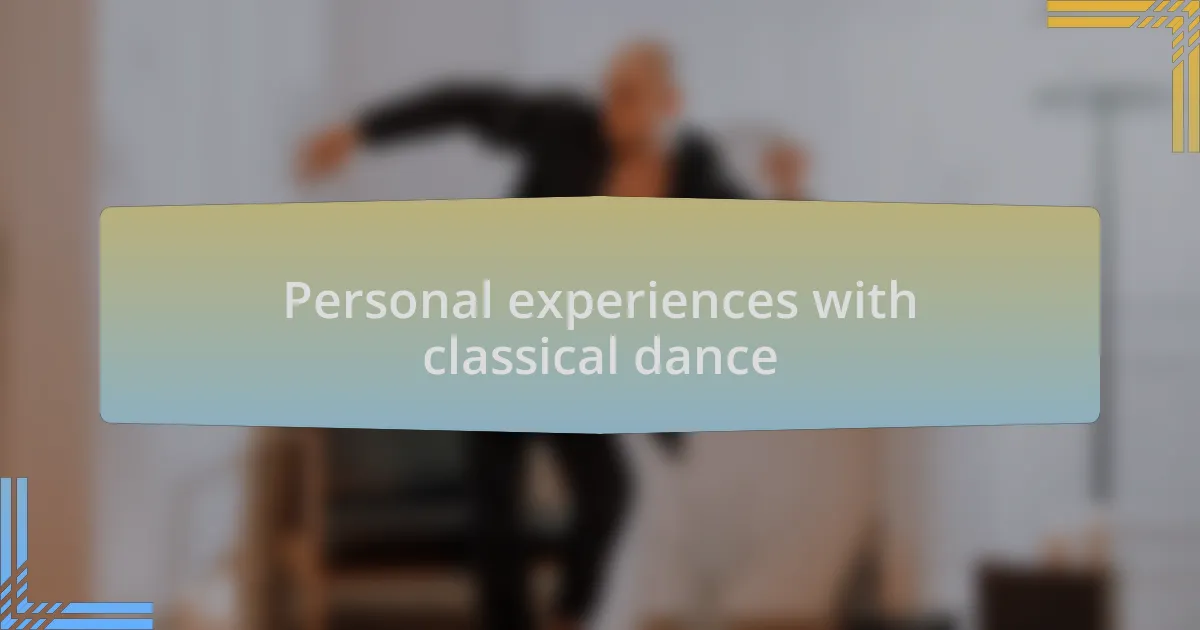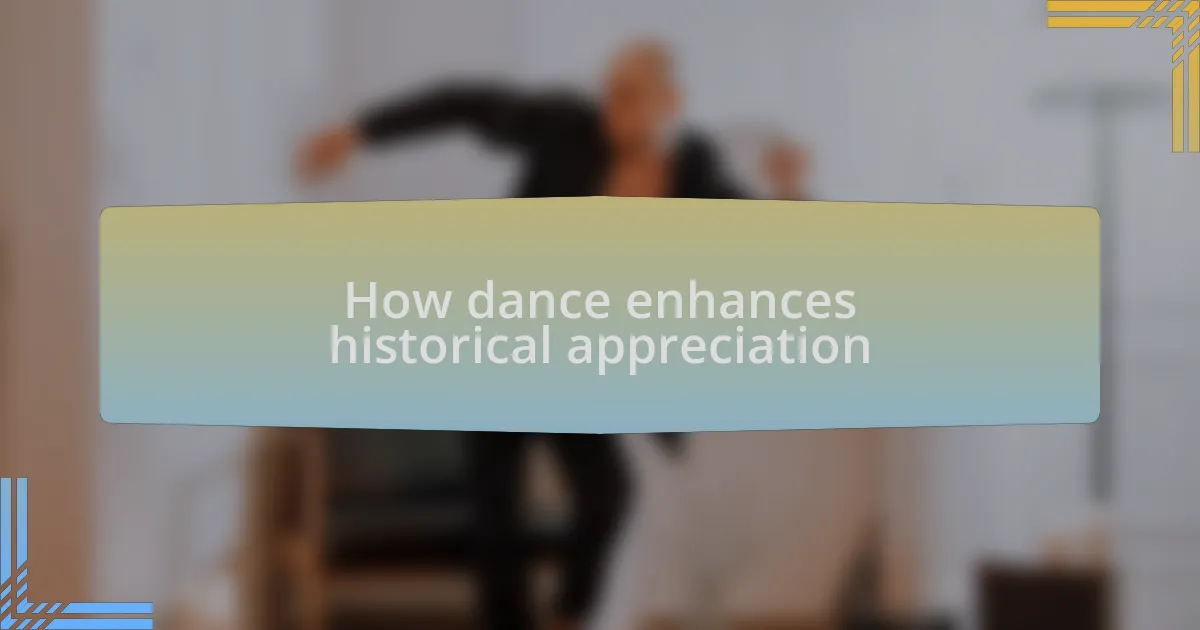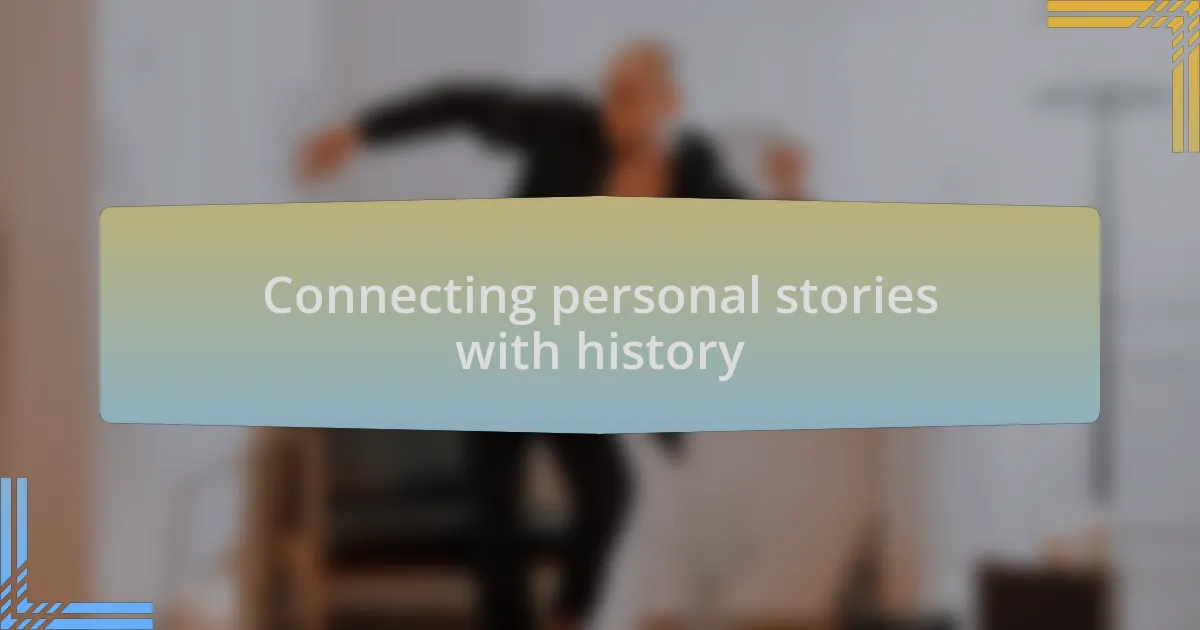Key takeaways:
- Classical Chinese dance reflects historical, philosophical, and cultural narratives through its movements and storytelling.
- The art form evolved significantly over centuries, influenced by rituals, cultural exchanges, and formalization in the Ming and Qing dynasties.
- Dance serves as a vital means of cultural expression, preserving and sharing the values and experiences of societies across generations.
- Personal experiences in dance create connections to history, allowing performers to embody and convey their own stories alongside ancient traditions.

Understanding classical Chinese dance
Classical Chinese dance is not just about moving gracefully; it embodies a rich tapestry of history, philosophy, and cultural identity. I remember the first time I watched a performance that seamlessly blended storytelling and movement; it felt like stepping into a vivid chapter of history. Each gesture conveys meaning, reflecting ancient traditions and beliefs that date back thousands of years.
What strikes me most is how classical Chinese dance incorporates the principles of Yin and Yang. The balance between soft, flowing motions and sharp, explosive movements captivates the viewer, making the dance a compelling narrative of harmony and conflict. Have you ever noticed how a single pose can evoke a sense of tranquility or turmoil? It’s in these contrasts that the dance truly speaks to the audience.
As I’ve delved deeper into this art form, I’m continually amazed by how each style, whether it’s the elegant and ethereal movements of the Han dynasty or the more vigorous gestures of the Tang, offers insights into the era from which it originates. It’s as if each performance is a portal, allowing us to experience the joys, sorrows, and aspirations of those who danced before us. Isn’t it fascinating to think that what we see on stage can connect us with shadows of the past?

History of classical Chinese dance
Classical Chinese dance has ancient roots, tracing back to rituals and ceremonies during the Xia and Shang dynasties over 3,000 years ago. I vividly remember visiting a historical site where dance was performed in honor of ancestors; the connection between movement and reverence was palpable. It was astonishing to comprehend how these early performances were not just entertainment, but a way to honor the divine and reinforce social bonds.
During the Tang dynasty, this art form evolved dramatically, influenced by cultural exchanges along the Silk Road. I felt a surge of excitement watching a contemporary performance inspired by this era, where the dances showcased vibrant costumes and bold expressions of joy. Isn’t it intriguing how this era’s openness to foreign ideas transformed classical dance into a more dynamic and expressive form?
By the time the Ming and Qing dynasties rolled around, classical Chinese dance began to take on structured styles, becoming deeply intertwined with operatic traditions. I remember attending a workshop where we explored these elaborate forms; it was enlightening to see how each movement and pose had specific meanings tied to the characters portrayed. This exploration deepened my appreciation for how historical contexts have continually enriched and refined this beautiful art form.

Cultural significance of dance
Dance embodies a powerful means of cultural expression, reflecting the values, beliefs, and history of a society. I remember attending a local festival where every dance performance told a story—from love and struggle to joy and triumph. It struck me how these movements didn’t just entertain; they taught us about our cultural heritage and brought us together in shared experiences.
In many cultures, including Chinese, dance serves as a historical archive, preserving narratives that might otherwise fade into obscurity. When I first learned a traditional dance, I felt a surge of connection to those who had danced it before me; their stories of resilience and celebration flowed through me. Isn’t it fascinating to consider how each step carries whispers of the past, echoing the lives of those who paved the way for our understanding of identity today?
Moreover, the symbolism in dance is often tied to significant cultural events and rituals, reinforcing community bonds. I once participated in a group performance meant to commemorate an important lunar festival, and the energy of collaboration was electric. It made me realize that our movements, steeped in tradition, unite us in purpose, reminding us of our shared heritage and the collective spirit that dance nurtures.

Personal experiences with classical dance
I still vividly recall my first ballet class, standing in front of the mirror, unsure of my footing. As I moved through the basic positions, it felt as though I was not just learning dance steps but also uncovering fragments of history. The way my teacher spoke about each movement, linking them to their origins, made me appreciate the art form on a deeper level. I wondered how many dancers had stood in the same spot, feeling the same blend of nervousness and excitement.
As I progressed, I participated in a performance celebrating traditional Chinese folklore. The intricate movements resonated with stories that transcended time, connecting me to a rich tapestry of cultural narratives. There was a palpable energy when we danced—a shared recognition of our roots. I felt honored to be part of such a significant expression of identity, realizing that through each turn and leap, I was a vessel for my ancestors’ stories. How incredible is it that we can breathe life into history through dance, making it relevant and alive in the moment?
Later, while watching a performance that featured classical dances from various Chinese dynasties, I was captivated by the way each style reflected distinct historical epochs. The fluid grace of one era contrasted sharply with the sharp, emphatic movements of another. Watching the dancers, I could almost feel the weight of their ancestors on their shoulders, urging them to tell their stories with every beat of the music. It was a powerful reminder that dance is more than art; it is the very heartbeat of history, guiding us as we step into our future.

How dance enhances historical appreciation
Dance serves as a unique bridge to history, allowing us to embody the very essence of bygone eras. I remember attending a workshop focused on the traditional fan dance of the Han Dynasty. As I learned to manipulate the fan with elegance and precision, it struck me that each movement was a whisper of the past, a way to connect with the lives and stories of those who danced before me. Isn’t it remarkable how such art forms can carry the weight of history within them, revealing cultural values and societal norms?
One particular performance I watched left a lasting impression on me. The dancers depicted a historical battle through their striking choreography, which was both fierce and graceful. As they moved, I felt a sense of the emotional landscapes they were portraying—courage, fear, and hope. The dance allowed me to weave together strands of history that I had only read about in books, transforming dry facts into a vivid narrative that danced before my eyes.
I’ve found that participating in dance provides a tangible connection to history, making the past feel alive rather than distant. When I take part in a group performance, there’s a collective energy that resonates deeply, as if we are channeling the spirits of our ancestors. How empowering is it to realize that through the act of dancing, I can contribute to an ongoing story, honoring those who shaped our cultural heritage?

Connecting personal stories with history
When I think about how my personal stories intertwine with history, I reflect on my first experience with a traditional Chinese dance piece that depicted ancient legends. Each practice session felt like peeling back layers of time, and in those moments, I wasn’t just learning choreography; I was stepping into the shoes of those who celebrated these tales centuries ago. How often do we have the opportunity to bring our personal journeys into a dance that connects us to the wisdom of the past?
One night, while preparing for a performance that honored the Tang Dynasty, I found myself overwhelmed with emotions. As I danced, I realized that I was not only conveying the story but also sharing fragments of my own story—my struggles, joys, and growth. It made me ponder: can our personal narratives enrich historical performances, transforming them into a dialogue between eras? The answer is a resounding yes; my dance became a tribute to both my experiences and those who walked before me.
It’s fascinating how each time I perform, I leave a piece of myself behind, creating a thread that links my present with history. In rehearsing intricate steps that have been passed down through generations, I can’t help but reflect on the countless dancers who have poured their hearts into the same movements. Don’t you feel a certain magic in knowing that our personal expressions can serve as vessels for historical continuity? Dance, for me, becomes a living tapestry where personal stories weave seamlessly with the rich fabric of history.